
 Liminal bodies in liminal spaces: the depiction of drug addicted youth in the films Christiane F and Drifter
Liminal bodies in liminal spaces: the depiction of drug addicted youth in the films Christiane F and Drifter
Introduction
The history of the “drug addiction film” can be traced back to the earliest days of cinema, from the silent short Hallucinations Pharmaceutiques (Georges Méliès 1908, France) through the cocaine comedies of the 1920s, such as The Mystery of the Leaping Fish (Cabenne and Emerson 1916), the marijuana Westerns of the 1930s such as High on the Range (Ben F. Wilson 1929 USA) to the exploitation movies of the 1940s like Cocaine Fiends (William O’Connor 1935, USA) and Reefer Madness (Louis Gasnier, 1936, USA).
One of the first films to offer a sincere and sympathetic portrayal of a heroin addict, told from the hero’s (Frank Sinatra’s) point of view, was The Man with the Golden Arm (Otto Preminger 1956). The film became a blueprint for many subsequent features that dealt with the addiction to hard drugs, such as heroin and cocaine [E 1].
Cinematic narratives about illicit drug use, crime and prostitution tend to be bound up with liminal city spaces and marginal urban characters. It is the aim of this article to explore the cinematic construction of one such liminal urban space, Zoo Station in Berlin – using as predominant points of reference two German films (Christiane F., 1981 and Drifter 2009) [E 2] – and to examine the ways in which these city spaces are used to mediate the experiences of young heroin addicts.
The eponymous protagonist of Christiane F. (played by Nadia Brunckhorst) is a neglected and lonely teenager from a broken family growing up in a grim housing estate on the outskirts of the city. Attracted by the glamour of one of David Bowie’s Berlin concerts, and in search of love and a sense of belonging, she is gradually lured into the sordid underbelly of the city – into drug addiction and prostitution. By contrast, Drifter follows the everyday lives of three youngsters who are homeless and already addicted to heroin. Both Christiane F. and Drifter are co-dependency stories, focusing predominantly on female adolescents Christiane (14) and Aileen (16), the relationship with their male junkie lovers (Detlef, played by Thomas Haustein, and Daniel) and their close male friends and “mentors” (Axel, and Angel) In both narratives it is the female drug addict who manages to “kick the habit” and leave her male partner behind. [63] I will argue that Christiane F. both glamorises and demonises drug addicts and the spaces they inhabit, thus tapping into the highly emotional West German media discourses about illicit drugs at the time. By contrast, Drifter, released nearly 30 years after Christiane F., is a sober account of drug addiction, and, so I would argue, indicative of the changes in the cultural perceptions of drug-taking since Christiane F.
The cultural context: from demonisation to normalisation
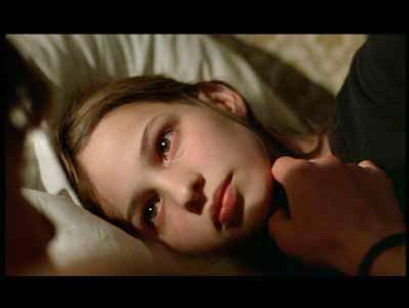 |
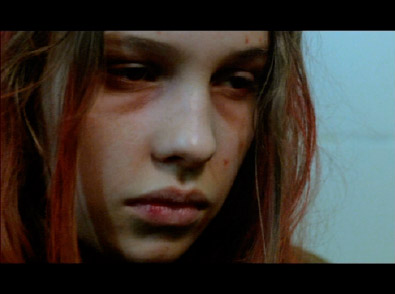 |
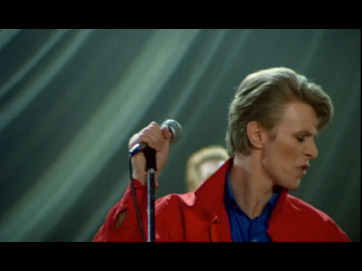 |
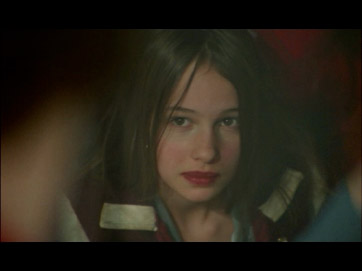 |
In the 1970s, the period during which Christiane F. is set, there was a dramatisation of the dangers of the so-called “drug wave” (“Rauschgiftwelle”) and of its alleged victims – a “host of young invalids” (das “Heer von Frühinvaliden”) – in heated parliament debates that were echoed in the media, for example in the popular television crime series “Aktenzeichen xy – ungelöst” (“Case xy – pending”) (Scheerer 1982a: 129). [E3] A condemnatory tone towards illicit drugs (including cannabis) began to dominate even those liberal newspapers that had previously taken a more open-minded stance: Und Haschisch schadet doch! (“And hashish WILL do damage!” Die Zeit, 30 August 1974). Drug policies in West Germany remained ‘hard line’, banning all drugs (and opiate substitutes like Methadone )[E4] in favour of total abstinence (Schmid 2003: 178 ff).
The advent of the AIDS epidemic in the 1980s and 1990s was to alter this situation drastically, once the connection between intravenous drug use and the HIV virus had been established. By the end of 2000, an estimated 50,000 to 60,000 people were registered as HIV positive in West Germany (AIDS-Zentrum im Robert Koch-Institut 2001: 3), many of whom were heroin users. In response to this situation, the notion of ‘harm reduction’ (such as free needle exchanges) entered the media discourses. In 1990, Akzept was founded – the Bundesverband für akzeptierende Drogenarbeit und humane Drogenpolitik e.V. (The Federal Association for Tolerant Drug Work and Humane Drugs Policy).
Akzept pleaded for an understanding of drug consumption as a lifestyle choice:
Eine so verstandene Drogenarbeit toleriert das Recht auf Anders-Sein von Drogengebrauchern, macht sie nicht zum Objekt von staatlich-therapeutischen und sozial-therapeutischen Massnahmen zum Zwecke der Integration durch unbedingte Abstinenz …
This concept of drug work tolerates the drug users’ right to be different, does not turn them into objects of therapeutic measures run by the state or social services in order to integrate them through absolute abstinence … (Schneider 1997:15)
In the mid 1990s, Kontaktläden (contact shops) for drug addicts were set up nationwide, providing temporary accommodation, cheap food, needle exchanges and drop-in consultations. These refuges for addicts, a large number of whom were homeless, became standard in urban centres with notorious ‘problem zones’ such as Berlin Zoo Station.
It is in this socio-political climate that the film Drifter is set, reflecting a change in the cultural discourses about illicit drug taking since Christiane F., from ‘demonisation’ to ‘normalisation’. [56] As Robert Stephens puts it:
The story of drugs in Germany, and in much of the industrial West, is a story about the complications of modernization. Rather than being understood merely as a peculiar form of crime, a type of sociological deviance, or a physical or psychological malady, drug consumption ought to be understood as a set of consumer practices deeply embedded in the ongoing process of global capitalist modernization (Stephens 2007:5).
Berlin Zoo Station – a liminal place
Prior to German unification in 1990, West Berlin was a liminal place, half of a divided city, part of , but not in, West Germany. Surrounded by the socialist Eastern Bloc during the Cold War, it had the atmosphere of a frontier outpost in enemy territory. Its insular geography and liminal political status attracted many young people from West Germany who rejected the dominant values of the Western ‘mainland’ and who favoured alternative lifestyles (such as gay rights, the Green and the peace movements).
The edgy, experimental feel of this half-city also held allure for international artists, who wished to reinvent themselves, such as the pop music icon, David Bowie. His producer Tony Visconti reminisced about their three years in Berlin:
… Berlin was perfect for him in terms of what he wanted at that time. It was a stark, scary place, yet it had a very exciting nightlife, with exotic locales such as the Turkish quarter, and it was swarming with artists like Tangerine Dream, who were friends of ours (Buskin 2004).
Heavily subsidised by the West German government – as a showcase for the success of the capitalist West – West Berlin became an affluent, glamorous post-WWII city. However, its promise and opportunities eluded those excluded from, and on the margins of, mainstream society, such as drug addicts. Bahnhof Zoo (Zoo Railway Station) fulfilled the role of a key transport hub of the Western half of the city for the forty years during which the country, and Berlin itself, was divided. This was where the Berliners boarded the trains that took them to the West and where travellers from West Germany reached their final destination; the last bastion and ‘frontier’ city of the Cold War.
Its notorious red light district often was, quite literally, the final destination for many drug addicts – who became visible to mainstream society only when they made the headlines as overdose victims. Even before the bestselling book and the cult film Christiane F. created the ‘Station Zoo myth’, its topography had been associated with the underworld of drug addicts, streetwalkers, and curb crawlers – in short, with the underbelly of the glitzy, swinging, liberal West Berlin. It was used, for example, as the location for films about a young social outcasts, such as in Das Ende des Regenbogens (The End of the Rainbow, Uwe Friessner 1979, W.Ger). Inevitably, Zoo Station remained a focus for filmmakers concerned with social issues.
Drifter was marketed as a remake of Christiane F., with the tag line Die Neuen Kinder vom Bahnhof Zoo (The New Children of Zoo Station), and contains many intertextual references to the earlier feature. In both films the protagonists’ heroin addiction is bound up with the spaces around Zoo Station, which has remained to this day a notorious haunt of junkies and streetwalkers.
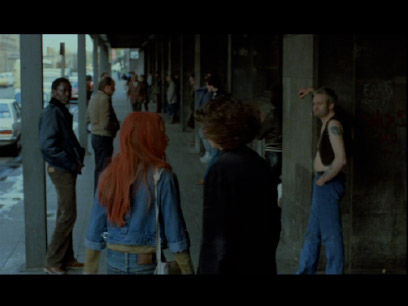 |
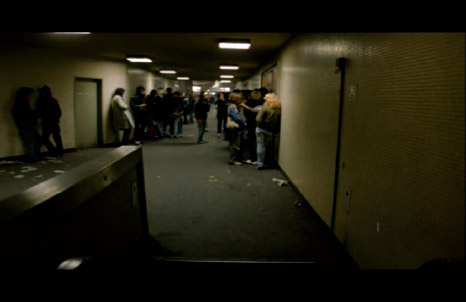 |
In Drifter, Aileen’s train journey from Berlin to her home village through the flat wintery countryside around the capital is clearly staged as a visual reference to Christiane F. The earlier film ends on a high angle shot of a white landscape, with Christiane’s voiceover stating that she now lives at her grandmother’s village where she has been able to stay ‘clean’ – the wide open spaces of the countryside signifying a ‘pure’ safe haven away from the corrupting influences of the big city. [E7] However, this brief ending scene is tagged on in a rather unconvincing fashion in Christiane F., not least because the wide empty spaces shot on a grey winter day look rather dull compared to the images of adventure in the big city that preceded it. Similarly, in Drifter, an extremely long take from Aileen’s point of view, looking out of the train window, shows the endless horizon of a bleak, flat winter landscape, which could be read as a metaphor of her feelings about the ‘normal’ life that awaits her in her home village.
Production and reception: ‘true stories’ of heroin addictions
Christiane F. (a feature film) and Drifter (a documentary) both tell the stories of ‘real’ people in their specific socio-historical contexts. The former is a docudrama based on the authentic case of a former heroin addict – Christiane Vera Felscherinow – first reported in the popular German news magazine Stern in 1978, then turned into the ghostwritten bestselling ‘autobiography’, the source of the cinematic adaptation (Hermann and Rieck 2009)
By the 1970s, West Germany had become Europe’s biggest market for illegal heroin, with an estimated 50,000 hard drug users still in their teens and West Berlin as Germany’s “junkie capital” (Brunn 1981). When the real Christiane F. was approached by the Stern reporters Kai Hermann and Horst Rieck, she had shaken her habit, but the story she told them of drug abuse, petty crime and child prostitution shocked a nation ignorant of the dimensions of the problem. The book remained on the bestseller list for over two years, with the vast majority of the readers being teenagers (Riehl-Heyse 1982/83, 78). The film adaptation became the most successful film in post-WWII West Germany history and a huge commercial success internationally, with top rankings in most other West European countries.
The media hype surrounding the published series of interviews with Christiane (in Stern), the ‘autobiographical’ novel and the film led to a veritable ‘Christiane F. fan pilgrimage’ to Berlin Zoo Station. The locations of the film became the sites of mass attraction – much to the consternation of West Berlin’s drug commissioner Wolf Heckmann, who claimed that the book and film had increased interest in drugs, and that young visitors to the city – who used to ask to see the Berlin Wall – now wanted to see Zoo Station (Heckmann 1982/83, 74).
The Christiane F. phenomenon caused a media-fuelled ‘moral panic’ in West Germany at the time and resulted, for example, in an entire double issue of the journal Medien (1982/83) being devoted to the topic of addiction in the cinema. Drawing predominantly on the approaches to drug taking in the social sciences, criminology, psychology and education, most contributions discussed the dangers of youth corruption by films such as Christiane F. [E 8]
Christiane F. and Drifter are similar generically too, as in both films the boundaries between documentary and fiction film are blurred. Aiming for authenticity, Uli Edel, the director of Christiane F. employed non-professional actors and – for the most part – a gritty documentary style. He shot almost exclusively on location, either with a steady steadycam or cam, as at Zoo Station, with a hidden handheld camera because the East German authorities (who owned all the railway stations in divided Berlin) had not granted shooting permission. Those sequences, staged with extras posing as addicts, came across as so ‘realistic’ that real life junkies unwittingly mixed with the cast. However, as Uli Edel stressed, the scenes in which the real heroin addicts had accidentally been captured were edited out in post-production for ethical reasons (Kolitzus 1981, 88).
While Christiane F. can be categorised as a docu-drama, Drifter is a dramatised documentary – a term used by its director Sebastian Heidinger. Drifter went beyond the mere documentation of moments in the youngsters’ everyday routine – the filmmakers created a rudimentary narrative arc in the post-production process, which resembles that of Christiane F. This involves a budding love relationship between Aileen and her junkie friend Daniel, Aileen’s deteriorating health, and her separation from Daniel after the return to her hometown.
Sebastian Heidinger, in the first instance, wanted to make a film about invisible people on the margins of society in general, including the poor, the homeless, beggars and other dispossessed people. It was only during his research of the subject that he became interested in young junkies, wanting to find out what drug addiction and dependency look like today (Freerix, 2007). He spent more than two months observing the ‘real life’ heroin users around Zoo Station, in order to gain access to their closed world and to win their trust. He and his cameraman parked their van there until he became part of the cityscape, offering his sofa to the young homeless as a resting stop and later as a casting couch. By the time he started shooting the film in 2007, the young users no longer noticed the camera.
Moreover, similar to the direct cinema documentary approach (Ward, 2005, 84), director Heidinger deliberately edited out the interviews he had conducted with the addicts before and during shooting, and withheld any voice-over comments on his protagonists’ drug addiction, thus managing to create an immediacy of images similar to that of a feature film. Heidinger financed the film by founding his own production company, Kollektiv Super 9, together with fellow graduates from the Berlin Film Academy, which allowed him to spend as much time as he needed on pre-production. This was the only way, he felt, to tackle the taboo topic of heroin addiction in a truthful and sensitive fashion (Heidinger 2008).
As he explained in an interview at the Berlin premiere of his film:
Eine Droge wie Heroin erschwert die Arbeit aus filmischer Sicht, weil der Konsum natürlich sehr mit Stereotypen besetzt ist und alles andere sehr schnell Gefahr läuft in den Hintergrund zu rücken. Das gleiche gilt auch für den Ort “Bahnhof Zoo” und den Mythos, der damit verbunden ist.
A drug such as heroin makes work more difficult, from a filmmaker’s point of view, because its consumption is loaded with stereotypes, and there is a danger that everything else will fade into the background. The same goes for the place “Zoo Station” and the myth connected with it (Heidinger 2008).
From demonization of heroin use in Christiane F. (1981) to normalisation of heroin use in Drifter (2009)
Despite the narrative and generic similarities between Christiane F. and Drifter, there are significant differences in their tone, their style and the ways in which they construct embodied spaces around Berlin Zoo Station in order to convey the experience of being heroin addicts – not least of course, due to the different socio-historical and cultural contexts in which they were produced and received.
The plot of Christiane F. relentlessly maps its protagonist’s downward spiral into heroin addiction in a highly dramatic fashion – from her reluctant first time ‘trying out’ heroin ‘just once’ to her regular use, to her collapse at home, to a gruesome ‘going cold turkey’ with her boyfriend, to a relapse and a near overdose, and her final redemption.
The circularity and repetitiveness of the junkies’ lives – earning money as streetwalkers, scoring dope, shooting up, being high, coming down – is emphasised not only in the narrative but also by the recurrent motifs of drug consumption with its paraphernalia, such as close-ups of needles piercing skin in long takes. This narrative pattern (with the exception of the final redemption), as well as its visual motifs are so characteristic of the cinematic depiction of heroin addiction – including more recent features, such as Trainspotting (Danny Boyle 1996, UK), (Darren Aronowsky 2000, USA) and Candy (Neil Armfield 2006, Australia) – that these films could be classified as a distinct genre in themselves. [9]
By contrast Drifter deliberately avoids showing the seedy side of the young addicts’ existence. The camera accompanies them throughout, but almost completely (with two brief exceptions) withholds any of the clichéd images of drug consumption, drug paraphernalia and prostitution. In fact, the topic of prostitution merely serves to produce one of the few mildly amusing moments in the film: Daniel and Aileen have a long conversation about of how prostitutes from Eastern Europe (in the competitive climate of globalisation) are ruining the prices in Berlin.
 |
|
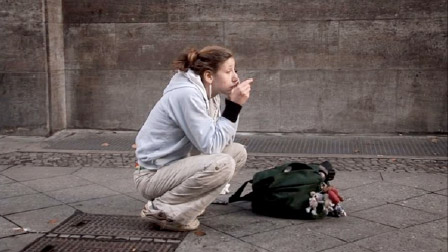 |
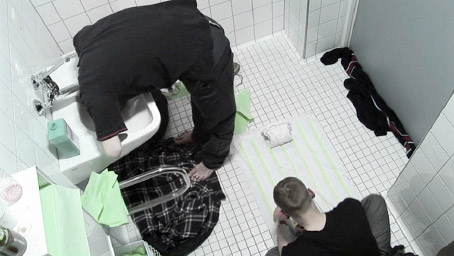 |
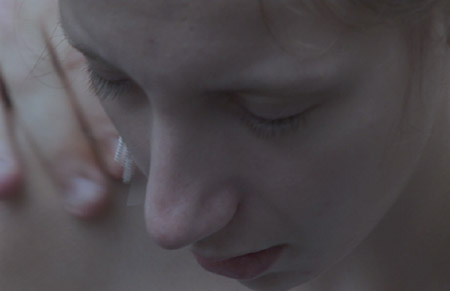 |
|
In a respectful and sensitive fashion that aims to leave the addicts their dignity, Drifter focuses exclusively on their normal everyday life and mundane routines in a ‘fly-on-the-wall’ mode. Thus we first encounter Angel and Aileen in a supermarket as they choose toiletries, such as deodorant and hair gel. Later on, and in similarly mundane spaces, we see Angel on his part-time job, meticulously cleaning a public toilet and Aileen trying to sell a paper in aid of the homeless to passengers who ignore her. Long sequence shots show Angel meticulously preparing a meal for a male client and then watching television together like an old married couple. On a sunny day, Aileen and Angel are seen to groom themselves on a public path, and at night they walk the streets in search of a place to sleep. The filmmakers restrict their focus to the heroin addicts’ friendship and their daily concerns, including the demands of their various clients, which they discuss in a matter-of-fact, almost ‘professional’ fashion.
Heidinger was conscious of the fact that his film would invite comparisons with Christiane F.:
Eine Neuauflage dieses Themas [Christiane F.] hat mich anfangs nicht interessiert, sondern eher gestört, auch weil die Jugendlichen … diesen Mythos kannten … Sie wollten die “neuen Kinder vom Bahnhof Zoo” darstellen ... Während des Arbeitsprozeses haben wir dann gelernt, den zugrunde liegenden Mythos als Chance zu begreifen. Man konnte sich an etwas reiben, mit Klischees und dem Mythos brechen.
Initially, the thought of a remake of this topic [Christiane F.] did not interest me, in fact it irritated me, not least because the youngsters knew this myth…They wanted to perform the “new children of Zoo Station”… But later on in the filmmaking process we learnt to perceive the myth [of Zoo Station] as an opportunity. We could resist something; break with clichés and with the myth (Heidinger 2008).
Christiane F: glamorisation and exploitation of the drug scene?
In contrast with Drifter, Christiane F. focuses on the extraordinary aspects of the junkie existence to dramatic effect, portraying its excitement as well as its dangers. The success and enduring cult status of this film can, at least in part, be accounted for by this approach which includes an element of ‘glamorisation’ of the drug scene, e.g. the stylish depiction of the nocturnal West Berlin spaces as ‘cool’ sites of adventure for young people, the depiction of heroin co-dependency as a gripping love story, and the powerful David Bowie music, which dominates the film’s soundtrack.
Bowie flew to Berlin from New York especially to agree the sale of nine tracks and the concert sequence that the film director wanted – offering these for “next to nothing” (fast geschenkt), because he regarded the film as das Beste, was bisher über dieses Thema gemacht wurde (the best that had been done about this topic to date) (Edel in Kolizius 1982/83, 90).
David Bowie is shown in a live concert performance of the song ‘Station to Station” (from the album Stage, 1978). [E 10] This nine minute long sequence is shot entirely from Christiane’s point of view, as she fights her way to the front row, fixing her mesmerised gaze upon the singer, while casually popping some pills. Drugs, such as tranquilisers and LSD – and ultimately heroin – are obtained and used freely amongst the Berlin youth subculture in order to ‘fit in’.
As one of the junkies in the disco Sound tells Christiane: “Be cool. Look around you. The cooler the guys look, the more they will have shot up.” She clearly idolises David Bowie, whose image is captured in close-ups on her album covers and on posters in underground stations, while the haunting voice and pulsating rhythms of his music (tracks taken from Bowie’s three Berlin albums) can be heard throughout the film. [E 11] Significantly it is straight after the Bowie concert that Christiane insists on trying heroin, and it is only after getting hooked on snorting heroin that she gravitates from the youth disco Sound to Zoo Station, where Detlef works as a rent boy.
Bowie, who was known to use hard drugs but still looked ‘cool’ and in control, arguably made those drugs fashionable to the mainstream. As a prominent member of the ‘Glam-Rock’ scene in the 1970s, he was also famous for staging flamboyant and provocative re-inventions of his star persona with striking changes in his physical appearance, all of which – as Matthew Pateman convincingly argues – revolved around issues of identity (2007, 130).
It is no surprise therefore, that rebellious teenagers – such as Christiane – seeking to find their own identity, and preoccupied with expressing themselves through fashion styles (Hebdige 1979), felt a special connection with the iconic pop star. The film articulates Christiane’s liminal state as a teenager at the age of 14 – stranded between childhood and adulthood – through contrasting images of her in private and public spaces. Repeatedly, she is portrayed as a lonely child at home, neglected and left to her own devices, snuggling up with her cat in bed, for instance, and blowing out the candles on her 14th birthday cake candles in isolation. These images are juxtaposed with her joining her peers at the youth disco Sound, posing as a young woman, wearing full make up and sporting a David Bowie fan jacket.
The film is mostly shot at night with cold blue-green lighting effects giving the seedy milieu both an eerie dreamlike quality and a degree of hyper-reality. The lighting creates an in-between state similar to that of the consciousness of the heroin addicts: young and full of life but constantly on the brink of death, and when high, neither fully awake nor fully asleep. The film further highlights the ‘in-betweenness’ of their condition by framing them predominantly in liminal and transitional “non-places” (Augé 2009), e.g. the area around Zoo Station with recurrent images of its deserted ticket hall and coach terminal at night, its rent boy strip, its public toilets and its labyrinthine underground station.
Conscious of the drug prevention lobby and the drug-demonising campaigns in the media [E 12], the director Uli Edel aimed to “demystify” hard drugs, as he called it (Kolitzius 1982/83, 91). Hence, he avoided any explicit depictions of junkies enjoying the drug taking experience – which have become somewhat of a standard motif in more recent heroin films. For instance in Traffic (Soederbergh 2000), when the drug commissioner’s daughter is using heroin for the first time, her pleasure is highlighted through an extreme close up of her angelic face filmed through a soft focus lens – we see her smiling with angelic bliss and a single tear running down her cheek.
By contrast, in Christiane F., the girl’s altered state of consciousness is expressed through the metaphorical use of space, enhanced by Bowie’s music. For instance, her first trip after snorting heroin is expressed metaphorically by a nocturnal car journey, with the youngsters’ vehicle penetrating an underground tunnel at speed (like the ‘rush’ users feel, when the drug enters their bloodstream), shot in a very long take as the Bowie song “TVC 15” (from the album Station to Station, 1976) kicks in – a piece that sounds uncanny, yet at the same time strangely blissful. [E 13]
Bowie’s Berlin albums drew on the latest technology at the time, creating soundscapes that experimented with time and acoustic space. The “Eventide Harmonizer” in particular, a processor which was “able to generate delay and reverb” (Whittaker 2009, 434), produced the effect of space-time relations being skewed – similar to the experience of being under the influence of mind-altering drugs.
The film’s director wanted his debut feature (and first collaboration with producer Bernd Eichinger [E 14]) to confront mainstream society with the problem of youth delinquency and drug abuse. When asked about his approach to this delicate and controversial topic, he expressed his anger at the passengers near Zoo Station who pretended the problem did not exist:
Als ich in Berlin für den Film zu recherchieren began, war das erste, was mir auffiel, dass die Fahrgäste im U-Bahnhof Kurfürstendamm die Leute aus der Heroinszene dort überhaupt nicht beachteten. Obwohl da manchmal 100 Kids standen. Das heisst: die Leute wussten schon, was da ablief, ignorierten es aber… Meine erste Idee war: ich werde die Leute mit meinem Film zwingen hinzuschauen. Sie werden die Augen nicht mehr abwenden können.
When I started my research in Berlin for this film, the first thing I noticed was that the passengers at the Kurfürstendamm tube station paid no attention whatsoever to the people from the heroin scene. Even though sometimes a hundred kids were hanging around down there. What I am saying is that people knew exactly what was happening but ignored it … My first idea was, I will make people take notice through my film. They will no longer be able to avert their eyes … (Edel in Kolitzus 1982, 88)
To this end, Edel employed a mixture of styles, initially filming in a social realist mode that invited empathy and identification with the film’s young heroine, but gradually introducing elements typical of the horror genre. Arguably however, by aiming to visually convey Christiane’s addiction as a demonic ‘horror trip’, he also inadvertently rendered the drug scene alluring, especially for young viewers – for whom the horror genre has always been appealing.
The area around Zoo Station is constructed as a dark and dangerous concrete jungle with very rare glimpses of natural light, “einem kahlen nächtlichen Neon-Dschungel, durch den die U-Bahnen kriechen wie klappernde Riesenschlangen” (a “stark nocturnal neon jungle through which tubes crawl like giant rattle snakes,”) (Bittorf 1981, 232). With Zoo Station as their feeding ground, feral predators are seen to prey on others, for instance in a graphic scene where a male junkie vaults a stall partition in the ladies toilet to rip Christiane’s fix from her hands and to shoot up in his neck in front of a shocked elderly lady.
In keeping with the imagery of the dark city jungle, the labyrinthine underground space at Zoo Station is the lair of the ‘demon drug’ (fulfilling a similar role as the horror movie monster). This is where the junkie victims are sucked dry and where they linger in a zombie-like state before their bloodless bodies are spat back onto the pavement when dead (as happens with two of Christiane’s close friends). [E 15]
At the end of Christiane’s final descent into the bowels of Zoo Station underground in search of money or dope, she is faced with blank stares by ‘zombie-faced’ junkies lining the subterranean corridors. Her trip through this hellish space, filmed in a long lateral tracking shot, is accompanied by a dramatic synthesizer-based ambience piece (“Sense of Doubt” from Bowie’s album Heroes, 1977), which powerfully evokes the gloomy space Christiane inhabits in that sequence. A pounding low register figure of four descending notes conveys an ominous sense of dread, with its slow pace and static feel enhancing the impression that she has reached rock bottom. At the same time, and perhaps despite the director’s intention, the musical and visual horror connotations in this sequence – both frightening and attractive, like the drug heroin itself – arguably could have a ‘cool’ appeal for some young viewers.
The young protagonists’ bodies, too, once they are hooked on heroin, are constructed in a horror-style fashion – both through their make-up (by the horror specialist and make-up artist Collin Arthur) and the editing technique. Extreme close-ups focus on the junkies’ abject bodies, on their blood, vomit and sweat, highlight their increasing physical deterioration. This is in contrast to most other heroin addiction films, like Panic in Needle Park, Drugstore Cowboy, Trainspotting, Requiem for a Dream and Candy, which continue to represent its protagonists as attractive youngsters even after they have had protracted use of heroin.
The recurrent close ups of these images of abjection, in particular of needles piercing skin and the syringe sucking in blood before releasing the drug also conjures up the notion of vampirism, as “the vampire’s union is brought about by the opening up of a wound” (Creed 1993, 70). Both the injection of heroin and the bite of the vampire create a ‘union’ between the user/victim and the heroin/vampire in a euphoric moment which often tends to be likened to a sexual climax (as in Christiane F., or Trainspotting). Again, these images are ambiguous if read in the specific context of the vampire genre: while the vampire connotes horror, it has also always been extremely popular with young viewers – as Milly Williamson demonstrates in The Lure of the Vampire (Williamson 2005).
The choice of horror aesthetics in Christiane F. is very much in keeping with public discourses constructing heroin addicts in the 1970s and 1980s as deviant outsiders of society (Schmid 2003, 180ff) as dirty ‘junkies’. The cultural geographer, David Sibley discusses notions of “purity and pollution” in his Geographies of Exclusion (1995, 60), which can be usefully applied here “… the polluting are more likely to be social and often spatially marginalised minorities like the gays, prostitutes and homeless …”. And one could add … the users of hard drugs. This is reflected in the change of Christiane’s appearance as she descends ever further into ‘polluted’ spaces, such as filthy alleyways, tube corridors and public toilets. The innocent ‘pure’ look of the schoolgirl, rosy-cheeked and bright-eyed, turns into the ‘dirty junkie’ stereotype with pale skin, scabrous veins, a spotty face and greasy hair. [E 16] However, this look – pale, skinny and hollow-eyed – with its connotations of teenage alienation and ‘cool’ defiance of the expectations of adults can also be read as appealing by some young viewers – evidenced in the “heroin chic” fashion of the 1990s (Giroux 1997, 20).
Not surprisingly, some West German, as well as international critics, accused Christiane F. of an exploitative approach because of its style and its exclusive focus on the taboo topics of illicit drug use and child prostitution to the exclusion of Christiane’s ‘normal’ life (such as school and family, described in the autobiographical book). [E 17] Sabine Hake, in her work German National Cinema, echoes these critics: “… the cautionary tale of a young girl’s descent into the world of hard drugs and sexual tricks … catered primarily to sensationalist impulses, and because of these qualities became a success at home and abroad” (Hake 2008: 175).
Hake, however, neglects the fact that the film’s appeal, especially for young people, was also due to the stylish depiction of nocturnal Berlin, and the use of David Bowie and his music as one of the Glam-Rock icons of its time. Moreover, young audiences identified with the sympathetic depiction of teenage rebellion. For instance, in an early sequence, Chistiane’s gang first vandalise a shopping mall and then ‘storming’ the tower of West Berlin’s Europa Center while being chased by the police – with David Bowie’s dynamic song Heroes seemingly egging them on.
At the time of the film’s release (certificate 16), the majority of its viewers (80%) were teenagers (Riehl-Heyse 1982/83: 79). A few years later, one such young viewer, Dagmar, explained in an interview what had impressed her most about the film at the time
Diese Wahnsinnsmusik von David Bowie. Die hat in mir so eine unbestimmte Sehnsucht ausgelöst. Und dann die Bilder vom nächtlichen Berlin.Wie die Kids da rumgeflipp sind wie Stadtindianer … So ein Gefühl von schrankenloser Freiheit … So wie diese Christiane F. wollte ich auch leben. Nachts in die Disco gehen, total gut drauf sein, niemandem Rechenschaft schuldig sein …
This awesome music by David Bowie. That triggered off some kind of vague longing inside me. And then the images of Berlin by night. How the kids ran wild like city raiders … Such a feeling of boundless freedom … I wanted to live like that Christiane, too. Going to the disco at night, feeling on top of the world, having to answer to no one … (Spiegel 1988: 103).
And even today, global viewers on blogs and online film sites such as IMDb.com and Amazon.com testify to the film’s strong impact, unanimously calling Christiane F. the most compelling and moving, but also haunting and disturbing example of the drug experience sub-genre, with comments like “it hits like a hammer” (Grann-Bach, Denmark IMDb 18 February 2010). Due to its authentic story, its gritty style and the credible acting of its young cast of lay actors, Christiane F. invited identification and triggered highly emotive, even visceral responses amongst viewers. Some of these online comments express feelings of sickness or intoxication, e.g. Pawan Maruvada from Visakhapathnam, India, concludes: “… I myself feel drugged watching this movie” (IMDb 2009) – a comment which evokes the notion of cinema itself as a drug – not only because of its addictive escapist quality but also its power to trigger embodied sensations (Boothroyd 2006, 194).
Drifter: heroin addiction in the post-modern city spaces
Such emotive responses eluded Drifter, the so-called ‘remake’ of Christiane F., due to the approach taken by its director. [18] Heidinger neither opted for the earlier film’s dramatic approach to heroin addiction and its aestheticisation for mainstream consumption, nor for the sensationalist approach favoured by some contemporary documentary filmmakers, for instance Morgan Spurlock’s documentary about food addiction, Supersize Me (2004, USA,).
Some critics praised the restrained observational style of Drifter, interpreting Heidinger’s tentative and sober look at the heroin addicts at Berlin Zoo Station as an aesthetic antithesis to those films of the drug film sub-genre, which chose this topic merely to indulge in “excesses” or “formal experimentation,” for instance Trainspotting, Requiem for a Dream, or Spun (Jonas Akerlund 2002, USA) (Hanich 2009).
Drifter (2009) is set in contemporary unified Berlin, no longer the epicentre of cold war tensions, but rather a metropolis characterised by postmodern global capitalism. Over the last two decades or so, globalisation has provided new supply routes for drugs to be readily available and easily accessible; and the new global media networks increasingly show drug consumption not just as a widespread common cultural practice but also as an intrinsic part of the new glamorised celebrity and consumer culture. However, as Heidinger points out, the post-modern consumer society has also created new spaces of exclusion.
In Europa, [werden] … öffentliche Räume … nicht nur weiter auf bestimmte Funktionen eingeengt, sondern auch zunehmend …von großen Konzernen “privatisiert” und auch als Eigentum gegenüber einer ungewollten Öffentlichkeit verteidigt – nämlich gegen diejeningen, welche nicht über ausreichende ökonomische Ressourcen verfügen.
In Europe … public city spaces ... [are being] not only reduced to specific functions [car traffic, consumption] but also increasingly … being ‘privatised’ by big concerns and defended as property… against an unwanted public – that is, those who do not dispose of sufficient economic resources (Heidinger 2009).
Drifter illuminates the few spaces that are left for those unwanted excluded people to inhabit thus conjuring up an image of Berlin that does not fit the official version of the new German capital, the metaphorical space for an emerging reunited nation, forward looking and dynamic. [E 19]
In contrast to the spaces embodied by Christiane F. (Gropius Stadt, the disco Sound and Zoo Station), all easily identifiable as iconic West Berlin landmarks, Drifter constructs the Berlin cityscape as a seemingly random assembly of fragmented, anonymous and interchangeable spaces which recall Deleuze’s notion of “any-space-whatever” (Deleuze 1986, 22).
The city is deliberately rendered unrecognisable – even to locals, according to the Berlin based film critic Ekkehard Knoerer (2009) – arguably to suggest that every global metropolis in the post-modern age has its ‘drifters’ on the margins of society. In Drifter, the real place Zoo Station and its surrounding area, are represented as a series of “disconnected or emptied spaces” (Deleuze 1986, 120), which have been removed from their geographical context and their “human co-ordinates” (Deleuze 1986, 22). The rootless and homeless protagonists drift through these spaces like post-modern urban tourists whose relationship with their environment Zygmund Bauman in his book Post-Modern Ethics has characterised as “physically close, spiritually remote” (1993, 243). Aileen, Daniel and Angel’s relationship with the spaces they transverse is also detached due to being under the constant influence of heroin (Aileen tells her GP she has used one bag of heroin a day for the last four months).
Heidinger constructs a narrative almost totally devoid of any drug-related drama and chooses a sparse, toned-down visual style. There is no non-diegetic music either – instead the loud diegetic traffic noise dominates the soundtrack, accentuating the fact that the characters literally live on the street. An often painfully slow pace with extremely long takes – even for a documentary of this mode and style – creates the impression that we are in ‘real time’ along with the characters. All these stylistic and narrative choices (such as the refusal to reveal the junkies’ personal background and motives for drug taking), I would argue, serve the film’s overall ‘normalisation’ strategy.
In contrast to Christiane F., the film moves away from the pathology discourses about heroin addicts, beyond the stereotypical narratives of the drug addict-user as morally weak or psychologically impaired, as the depraved and alien ‘Other’, towards a more nuanced approach. Drifter’s matter-of-fact approach to drug-heroin addicts reflects the changed attitudes towards drug users in Germany of the 21st century, as Schmid describes it:
Die Differenzen zwischen den akzeptierenden und abstienzorientierten Ansätzen verblassten allmählich … Auch der Konsum von illegalen Drogen vermochte kaum noch erregte öffentliche Debatten zu stimulieren.
The differences between the acceptance-orientated and abstinence-orientated approaches [to drug use] were gradually blurring. The consumption of illegal drugs, too, was no longer a topic to stimulate heated public debates (Schmid 2003, 227,228).
This changed understanding of drug use can also be observed in the wider context of post-modern capitalist societies. As the film and media scholar Paul Manning explains: “[Drug consumption today] is understood as a cultural practice, just as other patterns of consumption have to be” (2007, 25) – an understanding which is mediated in some of the more recent heroin films. For instance in Trainspotting (1996) drug consumption is explicitly chosen for the pleasures it provides; in Le Consequenze del’Amore/The Consequences of Love (2004) the protagonist enjoys long-term routine injections of heroin on Wednesday afternoons without being destroyed or even impaired by the ‘demon drug’; and in Candy (2006) the drug addict’s father decides to regulate his daughter’s heroin intake at home.
Drifter depicts its protagonists as ordinary young people who happen to live with a specific habit, which brings with it a certain lifestyle. However, while the film seems to accommodate the post-modern notion of drug taking as a cultural practice, the filmmaker is at the same time critical of that post-modern society:
… an ihrer Wirklichkeit [der Heroinsüchtigen] zeigt sich die “Krankheit” einer Gesellschaft, also die Konflikte, Spannungen und Auseinander—setzungen, die durch Modernisierungsschübe in der Struktur der Gesellschaft, aber vor allem im Gefüge der Familien und Generationen verursacht werden. Ihre Lage ist sicher auch Resultat einer fortschreitenden Individualisierung der Gesellschaft, die alle Schichten umfasst.
… the ‘illness’ of a society reveals itself in their [the heroin addicts’] reality; that is, the conflicts, tensions and struggles caused by modernisation of social the structures of society, but above all of the structure of families and generations. Their situation is certainly also the result of an increasing individualisation of society … that encompasses all classes (Heidinger 2009).
This new generation of social misfits is invisible in a different way. Unlike the junkies in Christiane F. who are driven to a nocturnal underground existence, these modern day addicts spend much of their time above ground, in broad daylight, among passers-by on train platforms, and on pavements. And unlike the shocking abject bodies in Christiane F., the addicts’ bodies in Drifter do not single them out as junkies or prostitutes. Quite the opposite, physically they are indistinguishable from ‘normal’ youngsters, as they take great care to groom their bodies in order to blend in with the crowd around the station.
They need to hide their underclass status as homeless people, in order to avoid being driven away by the police or shopkeepers who are anxious to keep public spaces ‘clean’ for the travellers and shoppers around Zoo Station.
As Heidinger explained:
Meiner Ansicht nach ist es heute für Menschen am Rand der Gesellschaft viel leichter, oberflächlich dazuzugehören. Man kann sich Markenklamotten anziehen oder besitzt ein Handy, doch die innerliche Entfremdung ist trotz dieser äusserlichen Annäherung viel stärker geworden. Es sind also unsichtbare Randgestalten unserer Gesellschaft.
In my opinion it is much easier today, in a superficial sense, for people on the margins of society to belong. They can put on fashionable clothes or own a mobile phone, but despite this external assimilation, their inner alienation has become much stronger. So, these are invisible marginal figures in our society (Heidinger in Wagner, 2008).
Being homeless, the junkies have no space to themselves. Instead, during daytime, they create their own private spaces in public, e.g. Aileen and Angel have a manicure session in the middle of a public path, ignoring and being ignored by the passers-by. And at nighttime, they seek shelter in a refuge or, if unsuccessful, they appropriate public spaces for their own private purposes. For instance, Daniel shares a disabled toilet in an anonymous public building with another addict and turns it into an ensuite makeshift bedroom (with toilet rolls for pillows). Away from the street, they silently proceed with their domestic activities – washing their socks, their hair and then reading or composing a letter.
Formally, Drifter enhances a sense of the junkies’ ‘remoteness’ and isolation from the spaces they embody by capturing their closed-off solipsistic world in mainly shallow focus, and by using an editing technique that avoids establishing shots. Sequences tend to start with extreme close-ups of an unidentified body part – such as a female neck and naked shoulders being massaged. Then, only very gradually, the frame is widened to reveal a little more of that person while showing only a small part of their surroundings, such as a fragment of a pavement or a fence in an unidentifiable street. The effect on the viewer is one of both frustration (at the “restricted view”) and disorientation: we, too, become part of the characters’ ‘bubble’ which isolates them from the rest of the city and its inhabitants.
Conclusion
The film Christiane F. portrays drug addicts as the exotic and alien ‘other’ – not only by glamorising the illicit drug scene (through the association with the stylish Glam-Rock star David Bowie and via the neo-noir-ish images of Berlin by night). But also by demonising the drug itself, showing its deprived victims as being possessed by heroin in images reminiscent of The Exorcist (William Friedkin 1973, USA).
I have argued, however, the ‘cool’ aesthetics of the horror and vampire genres may be counterproductive to the director’s aim. Arguably, they have contributed and still do to the film’s enduring appeal as a cult classic among young viewers.
By contrast, Drifter represents 21st century drug addicts as part of the everyday fabric of any global metropolis, while at the same time implicitly criticising mainstream society for excluding these. Moreover, while Christiane F. paints a horrific picture of abject junkies and the seedy spaces they inhabit, of the feral creature Christiane becomes during her descent into the sordid underbelly of West Berlin, Drifter challenges the demonisation of such marginal groups by blurring the distinction between the ‘ordinary’ teenage girl and the underage junkie through the use of the mise-en-scène (clothes, hairstyle, make up) and the against type framing of the heroine Aileen. She comes across as a young and confused (not very bright) girl next door.
Drifter, I have argued, also reflects the process of ‘normalisation’ of public attitudes towards drug consumption that has taken place in post-modern (Western capitalist) societies over the past two decades. It does so not just through its stylistic and narrative choices but also by showing that the German authorities today, like most of their European counterparts, no longer treat drug addiction as a punishable crime, but rather as an illness (EMCDDA, the European Monitoring Centre for Drugs and Drug Addiction 2010).
In the spirit of ‘damage control’, social services provide outpatient treatment centres and temporary overnight shelters, which make it easier for addicts to live with their habit. However, Drifter depicts these centres as stark transitional holding spaces where young ‘problem users’ are managed in a prison-like manner, keeping them out of the way of the general public.
Drifter suggests that, even though drug addicts are no longer driven underground, facing an almost certain drug-related death, they still remain excluded from, and invisible to, the mainstream population in the cityscapes of today. As the young addicts drift from one exchangeable space to another without being able or allowed to engage with it, this deceptively unassuming – but important – film shows how, for some, the post-modern cityscape has become synonymous with the lack of orientation, the lack of home, the lack of Heimat’.
Endnotes
1. Because of its subject matter it had to be released without Hollywood’s Seal of Approval but due to its success it triggered a revision of the Production Code to allow for the depiction of drug addiction on screen.
2. Both films are available on DVD with English subtitles.
3. I This is a slightly unusual variety of the co-dependency narrative which often shows the female addict of hard drugs (heroin, cocaine) to be unable or unwilling to give up (Panic in Needle Park, The Boost, Drugstore Cowboy, Candy).
4. In 1971/72 a new drugs law (“Betäubungsmittelgesetz” BtMG) was passed, which made all opiate-related acts illegal (including the prescription of heroin or its substitutes by GPs).
5. It was not until 1992 that a bill was passed, which allowed the treatment of heroin addicts with Methadone – a milestone on the path to normalisation – from criminalisation and punishment of drug users to acceptance and treatment (Schmidt 2003: 218).
6. For a discussion of the theory of drug normalisation, see Parker et. al (1998b) and Mark Simpson et al (2007) .
7. This is a slightly unusual variety of the co-dependency narrative which often shows the female addict of hard drugs (heroin, cocaine) to be unable or unwilling to give up (Panic in Needle Park, The Boost, Drugstore Cowboy, Candy).
8. The binary opposition of city and countryside is characteristic of discourses of modernity and was established at early as Sunrise – a Song of Two Humans (F. Murnau 1927, Ger.)
9. The special issue also contains an interview with the director Uli Edel and a report of a film discussion with adolescent viewers, which was broadcast on a major radio station (Riehl-Heye 1982/83: 77—81)
10. Other examples that deal with heroin addiction in this fashion include Panicin Needle Park (Jerry Schatzberg 1971 USA), Lady sings the Blues (Sidney J. Fury 1972 USA), Drugstore Cowboy (Gus van Sant 1989, USA), The Basketball Diaries (Scott Kalvert 1995) and Pure (Gillies MacKinnon 2003 UK). For a more extensive list of heroin films please see the filmography below. There are over 90 feature films that include the use of heroin. This paper is concerned only with those films in which the use of heroin and the experience of being addicted to heroin is at the centre of the narrative (excluding films in which the experience of drug use is incidental, e.g. thrillers).
11. This sequence was not shot in Berlin but at a concert in New York.
12. A compilation of Bowie’s soundtrack music for the film is available on CD, entitled Christiane F. Wir Kinder vom Bahnhof Zoo, Jones/Tintoretto Entertainment.co.uk 2001.
13. Most western European media echoed those in the USA endorsing Nixon’s “War on Drugs“ and Nancy Reagan’s “Just say No!” campaigns at the time.
14. Ironically the lyrics of “TVC 15” tells the story of a girl who gets sucked in by her television – another consumer “drug.”
15. The film was shot in only 82 days and on the relatively high budget – for a debut feature — of 3,5 million DM, co-produced by Bernd Eichinger (now a Hollywood star producer).
16. A parallel can be drawn both to Robin Wood’s notion of the monster in the Horror Film genre being a “threat to normality” (Wood 1986: 78)
17. In Christiane F. these visceral horror film aesthetics are particularly graphic in a gruesome withdrawal scene where Christiane and Detlef are shown to groan in pain, shiver, sweat, and shake in uncontrollable cramps, before projectile vomiting all over one another.
18. For example Herbert Riehl-Heyse in the Süddeutsche Zeitung (3 April 1981), Geoff Brown in The Times (London, 4 April 1981)
19. Drifter was shown at festivals (Leipzig 2007, Munich 2008, Nyon 2008, Vancouver 2008 and London 2008) and was awarded the Dialogue en Perspective/Perspektive Deutsches Kino in Berlin 2008, but has not met with the same media attention and controversy as the earlier film upon its release.
20. The dynamic new image of a post-unification, post-modern Berlin was evoked so powerfully in the film Lola Rennt (Run Lola Run Tom Tykwer 1999, Ger.) that the Berlin Mayor at the time, Eberhard Diepgen tried to use a poster of himself running (with the slogan “Diepgen rennt”) in order to exploit the film’s message for his election campaign (Hillenkamp 2001).
References
Aids-Zentrum im Robert Koch-Institut (2001): Bericht des AIDS-Zentrums in Rogert Koch-Insitut über aktuelle epidemiologische Daten in Deutschland (Stand vom 31.12.2000), in Epidemiologischer Bulletin, 27 February 2001 (Special Issue A), Berlin: Robert-Koch-institut, pp. 1–16
Anon., (2010) ‘Heroin Myths,’ http://www.drugscope.org.uk/resources/mediaguide/ heroinmyths, retrieved 21 July 2010.
Adams, Mark (2001) “The Music”, notes on the soundtrack CD Christiane F. Wir Kinder vom Bahnhof Zoo.
Augé, Marc (2009, 2nd ed) Non-places: Introduction to an Anthropology of Supermodernity, London: Verso.
Baumann, Zygmund (1993) Post-modern Ethics, Oxford: Blackwell.
Bittorf, Wilhelm (1981) “Irgendwas Irres muss laufen,” Der Spiegel, vol 35, no.15, pp. 230—245.
Boothroyd, Dave (2006) “Cinematic Heroin and Narcotic Modernity,” in Dave Boothroyd, Culture on Drugs. Narco-Cultural Studies of High Modernity, Manchester: Manchester University Press, pp. 186—205
Buskin, Richard (2004) “Classic Tracks: Heroes”, http://www.soundonsound.com/ sos/oct04/articles/classictracks.htm, retrieved 8 July 2010.
Clarke, David (2006) “In search of home: filming post-unification Berlin”, in David Clarke, German Cinema since Unification, London: Continuum, pp. 151–180.
Christiane F., Kai Hermann and Horst Rieck (2009, new edition) Wir Kinder vom Bahnhof Zoo, Carlsen Verlag Gmbh.
Creed, Barbara (1993) The Monstrous-Feminine: Film, Feminism, Psychoanalysis, London: Routledge.
Dagmar (1988) Interview about the film Wir Kinder vom Bahnhof Zoo, Der Spiegel, no. 52, p. 103.
De Certeau, Michel (1988) The Practice of Everyday Life, Berkeley, CA: University of California Press.
Douglas, Mary (1975) Implicit Meanings, London: Routledge
EMCDDA European Monitoring Centre for Drugs and Drug Addiction, http://www.emcdda.europa.eu/publications/country-overviews/de, retrieved 21 July 2010.
Freerix, Michel (2007) “Sebastian Heidinger: Drifter” http://www.jump-cut.de/filmkritik-drifter.html, retrieved 25 July 2010.
Giroux, Henry (1997) “Heroin Chic, Trendy Aesthetics, and the Politics of Pathology,”
New Art Examiner, no. 25, pp. 20—27.
Grist, Leighton (2007) “Drugs, the Family and Recent American Cinema,” in Paul
Manning (ed.) Drugs and Popular Culture: Drugs, Media and Identity in
Contemporary Society, Portland, Oregon: Willan Publishing, pp. 117–133.
Haake, Sabine (2008, 2nd ed.) German National Cinema, London and New York: Routledge.
Hanich, Julian (2009) “Wir Junkies von der Kurfürstenstrasse – behutsam, schmerzhaft,
fair: Sebastian Heidingers Doku ‘Drifter’ über Süchtige auf dem Strassenstrich,”
Tagesspiegel, 11 June 2009.
Hebdidge, Dick (1979) Subculture – The Meaning of Style, London and New York: Routledge.
Heckmann, Wolfgang (1982/83) “ ‘Wir Kinder vom Bahnhof Zoo’ als Unterrichts-thema?” Medien: Forum für aktuelle Probleme der Kommunikationspolitik und Medienpädagogik, nos. 4/5 “Sonderheft zum Thema: Sucht im Film,” pp. 72–76.
Heidinger, Sebastian (2009) “Anmerkungen des Regisseurs” http://www.salzgeber. de/presse/ pressehefte/drifter_ph.pdf.
Heidinger, Sebastian (2008) Interview for the television channel Arte at the Berlin Film Festival, http://www.arte.tv/popup_berlinale_2008/video-49-125.html, retrieved 28 June 2010.
Hillenkamp, Sven (2001) “Funktionierender Bürgermeister a.D.” http://www.zeit.de/2001/33/Funktionierender_Buergermeister_a_D_
, retrieved 20 July 2010.
Kolitzus, Helmut (1982) “Interview mit Uli Edel, Regisseur des Films ‘Christiane F. – Wir Kinder vom Bahnhof Zoo.’ Resumée der Entstehung des Film, des Inhalts und der Rezeption,” Medien: Forum für aktuelle Probleme der Kommunikationspolitik und Medienpädagogik, “Sonderheft zum Thema: Sucht im Film,” nos. 4/5, pp. 88–91.
Knoerer, Ekkehard (2009) “Drifter” www.filmzentrale.com/rezis2/drifterek.htm, retrieved 28 June 2010.
Kristeva, Julia (1982) Powers of Horror: An Essay on Abjection: Guildford: Columbia University Press
Manning, Paul (ed. 2007) Drugs and Popular Culture: Drugs, Media and Identity in
Contemporary Society, Portland, Oregon: Willan Publishing.
Maruvada, Pawan (24 June 2009) http://www.imdb.com/title?tt0082176, retrieved 14 July 2010.
Parker, Howard (2003) “Pathology or modernity? Rethinking risk factor analyses of young drug users,” Addiction Research and Theory, vol. 11, pp. 141–144.
Parker, Howard, Judith Aldrigde and Fiona Mesham (1998b) Illegal Leisure: The Normalization of Adolescent Recreational Drug Use, London: Routledge.
Pateman, Matthew (2007) “Structuring Stardom: Identity and the Transmigration of Image in the Work of David Bowie,” in Mary Valentis with Tara P. Monastero and Paula Zablonsky (eds) TechKnowledgies: New Imaginaries in the Humanities, Arts and TechnoSciences, Cambridge: Cambridge Scholars Publishing, pp.130–150.
Perone, James (2007) The Words and Music of David Bowie, Westport, Connecticut and London: Praeger Publications.
Powell, Anna (2007) Deleuze: Alterned States and Film, Edinburgh: Edinburgh University Press.
Riehl-Heyse, Herbert (1982/83) “Protokoll einner Hörfunkdiskussion über den Film ‘Christiane F. Wir Kinder vom Bahnhof Zoo’ – Wie vorbildlich ist Christiane F.?” Medien: Forum für aktuelle Probleme der Kommunikationspolitik und Medienpädagogik, vol. 4/5 “Sonderheft zum Thema: Sucht im Film,” pp. 77—81.
Scheerer, Sebastian (1982a) Die Genese der Betäubungsmittelgesetze in der Bundes
-republik Deutschland und den Niederlanden, Göttingen: Otto Schwarz & Co.
Schmid, Martin (2003) Drogenhilfe in Deutschland. Entstehung und Entwicklung 1970–2000, Frankfurt and New York: Campus Verlag.
Schneider, Wolfgang (1997) “Niedrigschwellige Angebote und akzeptanzorienterite
Drogenarbeit “, in Akzeptanz, vol 1997, no.1, pp 15—17.
Shaar Murray, Charles (2007) “David Bowie at 60” http://www.annachen.co.uk/bowiecsm. html, retrieved 8 July 2010.
Shapiro, Harry (2003) “The Pale Riders: Heroin films from Trash to Requiem for a Dream,” in Harry Shapiro, Shooting Stars: Drugs, Hollywood and the Movies, London: Serpent’s Tail, pp. 153–182.
Shapiro, Harry (1999) “ Dances with Drugs: Pop Music, Drugs and Youth Culture,” in Nigel South (ed.) Drugs: Cultures, Controls and Everyday Life, London: Sage Publications, pp. 17–35.
Sibley, David1995) Geographies of Exclusion. London: Routledge. Simpson, Mark, Tracy Shildrick and Robert MacDonald (2007 eds.) Drugs in Britain: Supply, Consumption and Control, Basingstoke and New York: Palgrave MacMillan.
Starks, Michael (1982) Cocaine Fiends and Reefer Madness. An Illustrated History of Drugs in the Movies, New York and London: Cornwall Books.
Stephens, Robert P. (2007) Germans on Drugs, Ann Arbor: University of Michigan Press.
Wagner, Steffen (2008) “Festivalblog – Interview mit Sebastian Heidinger, Regisseur von “Drifter”, http://www.festivalblog.com/archives/2008/02/festivalblogint.php5, retrieved 18 June 2010.
Warburton, Hamish, Paul Turnbull and Michael Hough (2005) Occasional and Controlled Heroin Use: Not a Problem? New Work: Joseph Rowntree Foundation.
Ward, Paul (2005) Documentary: The Margins of Reality, London: Wallflower Press.
Watson, Stephanie and Alex Recht (1999) “German Drug Cinema,” in Jack Stevenson, Addicted. The Myth and Menace of Drugs in Film, New York: Creation books, pp. 166–176.
Whittaker, Tom (2009) “Frozen Soundscapes in Control and Radio On,” Journal of British Cinema and Television, vol. 6, no 3 (December 2009), pp. 424–436.
Wood, Robin (1986) “The American Nightmare: Horror in the 70s,” in Robin Wood, Hollywood From Vietnam To Reagan, New York: Columbia University Press, pp 70–94.
Filmography
Boost, the (Harold Becker 1988 USA)
Basket Ball Diaries, the (Skott Kalvert 1995)
Better Things (Duane Hopkins 2008, UK)
Candy (Neil Armfield 2006 Austr.)
Christiane F. — We Children of Zoo Station (Uli Edel 1981, West Germany)
Consequences of Love/Le Consequenze de’ll Amore (Paolo Sorrentino 2004, It)
Dark Days (Marc Singer 2000)
Drifter (Sebastian Heidinger, Sebastian 2009, Germany)
Drugstore Cowboy (Gus van Sant 1989, USA)
Exorcist (William Friedkin 1973, USA)
Invisible (Konstantin Bojanov 2005, USA, Bulgaria)
Jesus‘ Son (Alison MacLean 2000, USA, Can.)
Lady sings the Blues (Sidney J. Fury 1973, USA)
Little Fish (Rowan Woods 2005, Australia)
Man with the Golden Arm, the (Otto Preminger 1956, USA)
Panic in Needle Park (Jerry Schatzberg Oct. 1971 USA)
Pure (Gillies MacKinnon 2003 UK)
Requiem for a Dream (Darren Aronofsky 2000 USA)
Rush (Lili Fini Zanuck 1991 USA)
Sherrybaby (Laurie Collyer 2006)
Spun (Jonas Akerlund 2002 USA)
Supersize Me (Morgan Spurlock 2004, USA, doc.)
Trainspotting (Danny Boyle 1996 UK)
Traffic (Steven Soderbergh 2000 USA)
About the author
Dr Andrea Rinke’ research interest has focused German cinema, media, and resulting in a wide range of publications in this area – most recently (2006) a monograph entitled From Models to Rebels and Misfits: The Representation of Women in East German Cinema (Edwin Mellen Press). Rinke’s research project on addiction and the cinema – which started a number of years ago – constitutes a shift in focus from national cinema into the interdisciplinary arena of Addiction Studies. In 2008, the author of this paper led an international conference on Addiction and Obsession at Kingston University, UK. Rinke is currently writing a monograph for Wallflower Press, entitled Getting High on Cinema – The Drug Experience Film.
Contact: a.rinke@kingston.ac.uk